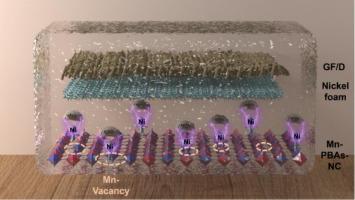Self-healing of manganese Prussian blue analogues via thermodynamically driven in situ engineered nickel cages in electrochemical processes
IF 14.9
1区 化学
Q1 Energy
引用次数: 0
Abstract
Although manganese Prussian blue analogues (Mn-PBAs) offer advantages as cost-effective, high-energy-density cathode materials for sodium-ion batteries, their practical application is severely constrained by substantial capacity degradation during long-term cycling. This performance deterioration is closely associated with the structural instability of the material during the cycling process, which is mainly attributed to the gradual dissolution of the active material into the electrolyte and severe lattice distortion during Na+ intercalation/deintercalation. Fortunately, the aforementioned challenges can be effectively addressed by fabricating an in situ engineered nickel cage (ISE-NC) on Mn-PBAs (denoted as Mn-PBAs-NC). Experimental characterization combined with theoretical calculations reveals that this spontaneously formed nickel cage not only suppresses the diffusion of Mn-PBAs into the electrolyte but also acts as a structural stabilizer, significantly alleviating lattice distortion during cycling. This dual stabilization mechanism ensures remarkable cycling stability, with Mn-PBAs-NC delivering a retained capacity of 96.4 mA h g−1 (80 % capacity retention) over 2,300 cycles at 2 C, elevating the cycle life of Mn-PBAs to unprecedented levels.

热驱动原位工程镍笼在电化学过程中锰普鲁士蓝类似物的自修复
尽管锰普鲁士蓝类似物(Mn-PBAs)作为钠离子电池的高能量密度正极材料具有成本效益,但其实际应用受到长期循环过程中大量容量退化的严重限制。这种性能的下降与循环过程中材料的结构不稳定密切相关,这主要是由于活性物质逐渐溶解到电解质中以及Na+插入/脱插过程中严重的晶格畸变。幸运的是,上述挑战可以通过在Mn-PBAs(表示为Mn-PBAs- nc)上制造原位工程镍保持架(ISE-NC)来有效解决。实验表征结合理论计算表明,这种自发形成的镍笼不仅可以抑制Mn-PBAs向电解质中的扩散,而且还可以作为结构稳定剂,显著减轻循环过程中的晶格畸变。这种双重稳定机制确保了显著的循环稳定性,在2℃下,Mn-PBAs- nc在2300次循环中提供了96.4 mA h g−1的保留容量(80%的容量保留),将Mn-PBAs的循环寿命提升到前所未有的水平。
本文章由计算机程序翻译,如有差异,请以英文原文为准。
求助全文
约1分钟内获得全文
求助全文
来源期刊

Journal of Energy Chemistry
CHEMISTRY, APPLIED-CHEMISTRY, PHYSICAL
CiteScore
19.10
自引率
8.40%
发文量
3631
审稿时长
15 days
期刊介绍:
The Journal of Energy Chemistry, the official publication of Science Press and the Dalian Institute of Chemical Physics, Chinese Academy of Sciences, serves as a platform for reporting creative research and innovative applications in energy chemistry. It mainly reports on creative researches and innovative applications of chemical conversions of fossil energy, carbon dioxide, electrochemical energy and hydrogen energy, as well as the conversions of biomass and solar energy related with chemical issues to promote academic exchanges in the field of energy chemistry and to accelerate the exploration, research and development of energy science and technologies.
This journal focuses on original research papers covering various topics within energy chemistry worldwide, including:
Optimized utilization of fossil energy
Hydrogen energy
Conversion and storage of electrochemical energy
Capture, storage, and chemical conversion of carbon dioxide
Materials and nanotechnologies for energy conversion and storage
Chemistry in biomass conversion
Chemistry in the utilization of solar energy
 求助内容:
求助内容: 应助结果提醒方式:
应助结果提醒方式:


